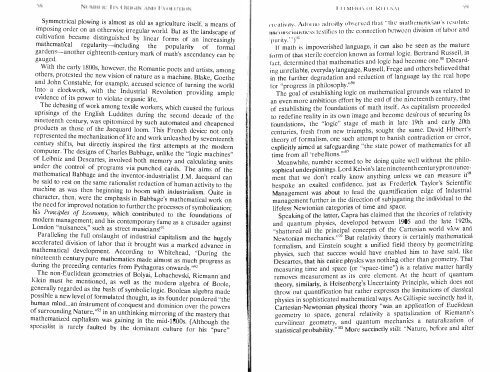CONTENTS - ouroboros ponderosa
CONTENTS - ouroboros ponderosa
CONTENTS - ouroboros ponderosa
You also want an ePaper? Increase the reach of your titles
YUMPU automatically turns print PDFs into web optimized ePapers that Google loves.
Symmetrical plowing is almost as old as agriculture itself a means of<br />
imposing order on an otherwise irregular world. But as the landscape of<br />
cultlvatJon became distinguished by linear forms of an increasingly<br />
mathematical regularity-including the popularity of formal<br />
gardens-another eighteenth-century mark of math's ascendancy can be<br />
gauged.<br />
With the early 1800s, howcver, the Romantic pocts and artists, among<br />
others, protested the new vision of nature as a machine. Blake, Goethe<br />
and John Constable, for example, accused science of turning the world<br />
mtG a clockwork, with thc Industrial Revolution providing ample<br />
eVIdence of Its power to violate organic life_<br />
The dcbasing of work among textile workers, which caused the furious<br />
uprisings of the English Luddites during the second decade of the<br />
nineteenth century, was epitomized by such automated and cheapencd<br />
products as those of the Jac4uard loom. This French device not only<br />
represented the mechanization of life and work unleashed by seventeenth<br />
century shifts, but directly inspired the first attempts at the modern<br />
computer. Thc designs of Charles Babbage, unlike the "logic machines"<br />
of Lelbnlz and Descartes, involved both memory and calculating units<br />
under the control of programs via punched cards. The aims of the<br />
mathematical 13ahbagc and the inventor-industrialist J.M. Jacquard can<br />
be saId to rest on the same rationalist reduction of human activity to the<br />
machme as was then heginning to boom with industrialism. Quite in<br />
character, then, were the emphasis in Babbage's mathcmatical work on<br />
the necd for improved notation to further the processes of symbolization;<br />
hIS PrmClples of lo'conomy, which contributed to the foundations of<br />
modern managcment; and his contemporary fame as a crusader against<br />
London "nuisances," such as street musicians!91<br />
Paralleling the . full onslaught of industrial capitalism and the hugely<br />
accelerated diVISion of labor that it hrought was a marked advance in<br />
mathematical development. According to Whitehead, "During the<br />
nIneteenth century pure mathematics made almost as much progress as<br />
durIng the prccedIng centunes from Pythagoras onwards. ""<br />
The non-Euclidean geometries of Bolyai, Lobachevski, Riemann and<br />
Klcin must be mentioncd, as well as the modern algehra of Boole,<br />
gcne . rally regarded as the baSIS of symbolic logic. Boolean algebra made<br />
pOSSIble a new level of t(lrmulated thought, as its founder pondered "the<br />
human mmd ... an Instrument of conquest and dominion over the powers<br />
of surrounding Nature,"" in an unthinking mirroring of the mastery that<br />
mathcatlzed caPltaltsm was gaining in the mid-ISOOs. (Although the<br />
specrahst IS rarely faulIed by the dominant culture for his "pure"<br />
.<br />
I ' ll MI'N I". (II 1{1- 111'.;\1<br />
Cl'calivilv, ;\ dllrtHl adroitly (lhsl..:rved that "the IlIatlll:maticiall's rcsolutl..:<br />
IIlh'OIl'il'-i(lLiSneSS tt.:slifil:s to the c()nncti()n bt.:twccn division of lahor and<br />
'purity. "'f'\<br />
If math is impoverished language, It can also be seen as the mature<br />
t()rm of that sterile coercion known as formal logic. Bertrand , Russell, In<br />
het determined that mathematics and logic had hecome one." Dlscard<br />
ig JI1rcliahle, everyday language, Russell, Frege and othcrs believed that<br />
in the further degradation and rcduction of language lay the real hope<br />
for "progress in philosophy."9<br />
The goal of establishing logic on mathematical grounds was related to<br />
an even more ambitious effort by the end of the mncteenth century, that<br />
of establishing the foundations of math itself. As capitalIsm proceeded<br />
to redefine reality in its own image and become dcSIrous 01 secunng Its<br />
loundations, the "logic" stage of math in latc 19th and . earl 20t<br />
centuries, fresh from new triumphs, sought the samc. DaVId Hllhert s<br />
theory of formalism, one such attempt to banish contradictIon .or rror,<br />
explicitly aimed at safeguarding "the state power of mathematiCs lor all<br />
f II ' b II' ,,,97<br />
time rom a Ie e Ions.<br />
.<br />
Meanwhile, number seemed to bc doing 4uite well without the phIlo<br />
sophical underpinnings. Lord Kelvin's late nineteenth centuryproounc,;;<br />
ment that we don't really know anythmg unless we can ',"easure It .<br />
bespoke an exalted confidence, just as Fredenck Taylor s SCIentIfIc<br />
Management was about to lead the quantification edge .of Industrial<br />
management further in the direction of subjugatmg the tndlVldual to the<br />
lifeless Newtonian categories of time and space.<br />
Speaking of the latter, Capra has claimed that the theories of relatiVity<br />
and quantum physics, developed between 1905 a . nd the laW<br />
.<br />
.<br />
. .<br />
1920s,<br />
.<br />
"shattered all the principal concepts of the Cartesian world vIew and<br />
Newtonian mechanics."" But relativity theory is certainly mathematrcal<br />
formalism, and Einstein sought a unified field theory by geometrlZlng<br />
physics, such that success would have enabled him to have saId, lIke<br />
Descartcs, that his entire phYSICS was nothmg other than geometry. That<br />
measuring time and space (or "space-time") i, a relative matter hardly<br />
removes measurement as its core element. At the heart of 4uantum<br />
theory, similarly, is Heisenberg's Uncertainty Principle, which does not<br />
throw out quantification but rather expresses the hmltattons of classlc 1<br />
physics in sophisticated mathematical ways. As Gtlhsple SUCCInctly had It,<br />
,<br />
Cartcsian-Newtonian physical theory "wa, an apphcatlon of Euchdcan<br />
geometry to space, general relativity a spatialization ot Riemann's<br />
curvilinear geometry, and quantum mechamcs a naturalIzation of<br />
statistical probability.",m More succinctly still: "Nature, hefore and after






